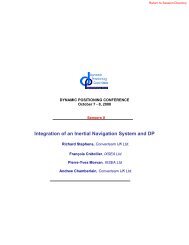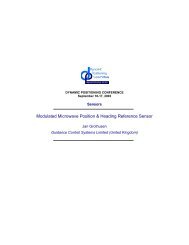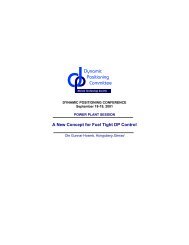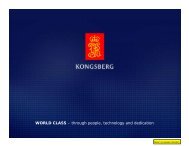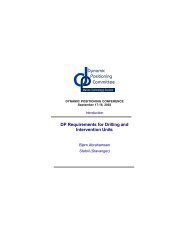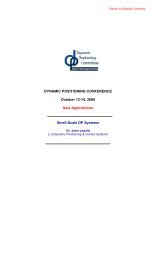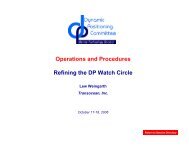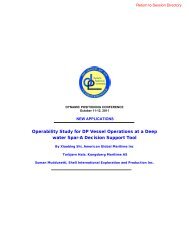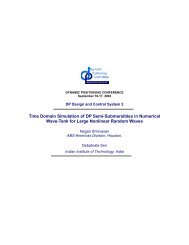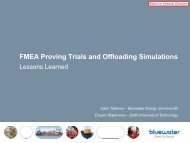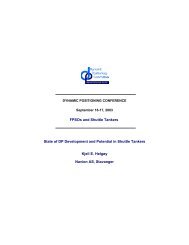Diesel Engine and the Environment - Clean Shipping Technology
Diesel Engine and the Environment - Clean Shipping Technology
Diesel Engine and the Environment - Clean Shipping Technology
- No tags were found...
Create successful ePaper yourself
Turn your PDF publications into a flip-book with our unique Google optimized e-Paper software.
ENVIRONMENTThe <strong>Diesel</strong> <strong>Engine</strong> <strong>and</strong> <strong>the</strong> <strong>Environment</strong>David SteffensWartsila North America, Inc.Session Chair – Wayne Cole, Cole <strong>Engine</strong>eringSeptember 16-17, 2003Houston, Texas
IntroductionThe diesel engine <strong>and</strong> <strong>the</strong> environment- rules <strong>and</strong> regulations- emission reduction technologiesReturn to Session Directory
Typical composition of diesel engine WFI-M exhaust Marine gasToge<strong>the</strong>r> 99.5%Nitrogen N 2 : 76%Oxygen O 2 : 13%Carbon dioxide CO 2 : 5% Low due to high efficiencyWater H 2 O: 5%Sulphur oxides SO X Fuel choice relatedCarbon monoxide CO Low due to good combustionHydrocarbons C X H y Low due to good combustionParticlesLow at steady state operationInfluenced by fuel ash <strong>and</strong>sulphur contentVisible smoke FSN Low load related (
Exhaust compounds <strong>and</strong> <strong>the</strong>ir environmental impactNO x:– acid rain, acidification– ozone/smog formation in <strong>the</strong> lower atmosphere(potential damage on vegetation <strong>and</strong> human health)Particulates:– some considered carcinogenic– blackening with sootSO x:– acid rain, acidification– potential detrimental effect on human healthCO:– ozone/smog formation in <strong>the</strong> lower atmosphereHydrocarbons:– ozone/smog formation in <strong>the</strong> lower atmosphere– some considered carcinogenic– contribute to <strong>the</strong> greenhouse effectCO 2:– <strong>the</strong> major greenhouse gasReturn to Session Directory
<strong>Diesel</strong> NO XFormationThermal NO X formation (65-75%)Nitrogen source:combustion airFormation process: extremely complex including hundreds ofdifferent reactionsStrong temperature influence (exponential)Return to Session Directory
20181614121086420Thermal NO x FormationNO x Equilibrium Concentration20040060080010001200140016001800200022002400Local Temperature (K)Relative NOx -ConcentrationReturn to Session Directory
Typical NO x -Emissions for DifferentTypes of <strong>Engine</strong>sTypical NO x Emissions in g/kWh:138840.651.3<strong>Diesel</strong>Liquid FuelGas<strong>Diesel</strong>Lean BurnGas <strong>Engine</strong>Return to Session Directory
14NOx emissions of different prime moversoperating on MGO1210NOx g/kWh86420<strong>Diesel</strong> engine withSelective CatalyticReductionAeroderivative gasturbine<strong>Diesel</strong> engine withDirect WaterInjection<strong>Diesel</strong> engineReturn to Session Directory
Emission reductionTechnologies to reduce emissions:• Primary Methods - During Combustion• Secondary Methods - After CombustionReturn to Session Directory
Primary NO xcontrol - diesel enginesAvailable today - Combustion ModificationEmission rating– Adjustment of fuel injection timing/TC specification–NO x reduction potential: 10 - 20 %– Simple <strong>and</strong> cheap– Increased fuel consumption <strong>and</strong> <strong>the</strong>rmal loadLow NO x combustion– Rearranged diesel cycle–NO x reduction typically: 25 - 35 %–NO x well below <strong>the</strong> IMO limit– Unchanged or improved fuel consumptionReturn to Session Directory
Primary NO xcontrol - diesel enginesAvailable today - Water InjectionWater-in-fuel emulsions– Humidification of <strong>the</strong> combustion process–NO x reduction potential typically: 20 %– Limitations• emulsion stability• fuel injection system capacity• poor engine performance in “non-water” operational mode• cavitation risk in injection systemDirect water injection– Humidification of <strong>the</strong> combustion process–NO x reduction typically: 50 - 60 %– Improved <strong>the</strong>rmal load <strong>and</strong> engine cleanlinessReturn to Session Directory
Low NO XCombustion <strong>Engine</strong> DesignRearranged diesel cycle– Very late fuel injection start– Higher compression ratio– Early inlet valve closing (4-stroke)– Late exhaust closing (2-stroke)– Optimized combustion chamber– Optimized fuel injection pressureResults– Lower combustion temperatures– Shorter duration at high temperaturesConclusions–NO X reduction typically 25-35%– Unaffected fuel consumptionReturn to Session Directory
Low NO x CombustionApplication: All Fuel TypesConventional Design<strong>Engine</strong> Maximum Firing PressureLow NO x Design<strong>Engine</strong> Maximum Firing PressurePressure riseinduced fromcombustionPressure riseinduced fromcombustionCylinder PressurePressure riseinduced fromcompressionCylinder PressurePressure riseinduced fromcompression-90 -60 -30 0 30 60 90 120 -90 -60 -30 0 30 60 90 120TDCTDCReturn to Session Directory
Implementation of Low NO x Combustion onWärtsilä Vasa 32bRelative NO x EmissionsRelative Spec. Fuel Cons.100%100%97%80%Compr.RatioWV32Σ = 12WV32LNΣ = 13.8WV32Σ = 12WV32LNΣ = 13.8Return to Session Directory
DisadvantagesFeatures of fuel-water emulsions– Increased camshaft torque <strong>and</strong> cam load.– Full load of engine not possible at high water ratios due tolimitations in <strong>the</strong> fuel injection equipment.– Same nozzles not optimal for operation with <strong>and</strong> withoutemulsion.– Negative impact on injection equipment reliability <strong>and</strong>lifetime.– Increased fuel viscosity, higher preheating temperaturesneeded.Advantages– Improved low load smoke.– Lower NOx. The NOx limitation is limited to about 20%,because unlimited water amounts cannot be kept in a stableemulsion.Return to Session Directory
FSNMEC Test on W6L46CR, Vaasa2-19 December 2002INFLUENCE OF WATER EMULSION ON FSNSt<strong>and</strong>ard Nozzle: 12x0.64x160°, Fuel: HFO0.800.700.60FSN0.500.400.30W/F ratio = 0, without MECW/F ratio = 0, with MECW/F ratio = 0.1W/F ratio = 0.2W/F ratio = 0.30.200.100.000 10 20 30 40 50 60 70 80 90 100 110<strong>Engine</strong> load [%]Return to Session Directory
NO xemissionsMEC Test on W6L46CR, Vaasa2-19 December 2002INFLUENCE OF WATER EMULSION ON NO x EMISSIONSSt<strong>and</strong>ard Nozzle: 12x0.64x160°, Fuel: HFOReference NOx: Without MEC1.000.95Relative NO0.900.85100% load85% load75% load50% load0.800.750.00 0.05 0.10 0.15 0.20 0.25 0.30 0.35W/F ratioReturn to Session Directory
Return to Session DirectoryThe principle of Direct Water Injection
Direct Water InjectionWatertankWaterControlHigh pressure unitwater pumpFlow fuseSolenoidvalveFuelTFuel needleWater needleReturn to Session Directory
Return to Session DirectoryDirect Water Injectiontypical water/fuel timing <strong>and</strong> duration
Emission Control Technologies - Tomorrow’s solutionsFuture Technologies:•CASS (Combustion Air Saturation System)Return to Session Directory
CASSCASSCompressor“Intercooler”/heaterWater injectionReceiverWater injectionThe hot air after <strong>the</strong> compressor is cooledto <strong>the</strong> saturation point by injecting watermistHeatAfter heating in <strong>the</strong> “charge air cooler” <strong>the</strong>mixture is again saturated by injecting ofmore waterHeating of <strong>the</strong> air by HT-waterReturn to Session Directory
Efficiency of humidification methodsRelative NO xformation1.11.00.90.80.70.60.50.40.30.20.1Direct WaterInjectionCombustion Air HumidificationW20W320.5 1.0 1.5 2.0Water/Fuel flow ratioReturn to Session Directory
Predicted NOx behavior with different controlmethods on Wärtsilä 46NOx15Fuel Water Emulsion10CASSFWE + CASS550 100 150 200 250Water amount as % of fuel consumptionReturn to Session Directory
Secondary NO xcontrol - diesel enginesAvailable todaySelective catalytic reduction (SCR)–NO x reduction typically: 85 - 95 %– Urea/water solution injected– Integrated part of <strong>the</strong> engine package– Exhaust temperature window 330 - 450 °C at HFO operation– Investment <strong>and</strong> operating costs relatively highCompact SCR– Combined silencer <strong>and</strong> SCR unit– Minimized sizeReturn to Session Directory
Return to Session DirectoryPrinciple of Selective Catalytic Reduction
SCR Reactions With Urea• Before Entering <strong>the</strong> Reactor:(NH 2 ) 2 CO + H 2 O 2 NH 3 + CO 2• In <strong>the</strong> Reactor:4 NO + 4 NH 3 + O 2 4 N 2 + 6 H 2 O6 NO 2 + 8 NH 3 7 N 2 + 12 H 2 OReturn to Session Directory
Retrofit of Compact SCRBirka Princess at Lloyd WerftSCR plants have beenretrofitted in several passengerships in existing engine casing= no lost space!A Compact SCR occupies alittle more space than a normalsilencer which it replaces.Return to Session Directory
Smokeless <strong>Diesel</strong> <strong>Engine</strong>Particle Emissions– Particle emissions are seen as smoke– More prevalent at low loads <strong>and</strong> start-upSmoke Reduction Methods– Common rail fuel injectionReturn to Session Directory
Smokeless <strong>Diesel</strong> <strong>Engine</strong>Targets for <strong>the</strong> Smokeless <strong>Engine</strong>• No visible smoke at start-up• No visible smoke at any load• NO x emissions to be reduced• CO 2 emissions to be reduced even lower by fur<strong>the</strong>rimprovements in efficiencyReturn to Session Directory
Conventional vs common rail fuel injectionConventional injectionsystemMechanical./hydrauliccontrol at <strong>the</strong> injectorsCommon Rail InjectionElectronic / hydrauliccontrol of injectionConstant fuelpressureFuel pressureproduced each timeby <strong>the</strong> injection pumpReturn to Session Directory
Return to Session DirectoryWÄRTSILÄ COMMON RAIL SYSTEM
Common Rail advantages• Smokeless operation at all loads <strong>and</strong> speeds.• Smokeless start of <strong>the</strong> engine.• Smokeless load pick-up ramps.• NOx reduction down to 3…4 g/kWh with humidificationpossible without visible smoke.• Improved total fuel economy.• Flexibility for different fuels without hardware modifications(heavy fuel, diesel oil, gas turbine fuel, water-fuel emulsion).• Improved safety <strong>and</strong> comfort because more engines can bekept running with still good fuel economy <strong>and</strong> no smoke.Return to Session Directory
Wärtsilä 46 Common RailFSN status at engine laboratory <strong>and</strong> delivery test runFilter smoke number0.50.450.40.350.30.250.20.150.10.050Production enginesMay 2002 <strong>and</strong> forupgrading*THIS ISSMOKELESSBest lab.resultswith modifiedpiston shape*0 10 20 30 40 50 60 70 80 90 100 110*<strong>Engine</strong> load (%)Conventional injection**Return to Session Directory



